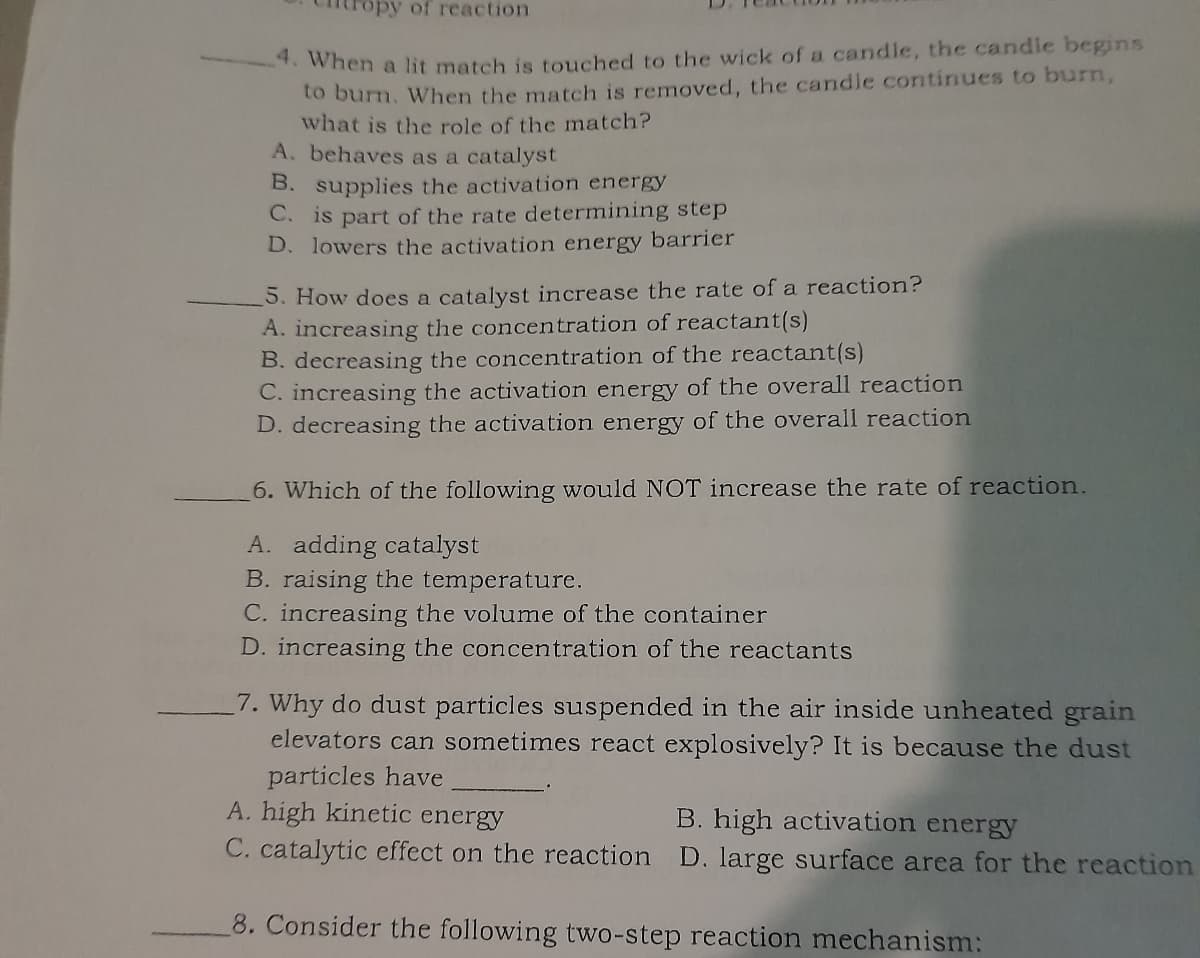py of reaction . When a lit match is touched to the wick of a candle, the candie begins to burn. When the match is removed, the candle continues to burn, what is the role of the match? A. behaves as a catalyst B. supplies the activation energy C. is part of the rate determining step D. lowers the activation energy barrier 5. How does a catalyst increase the rate of a reaction? A. increasing the concentration of reactant(s) B. decreasing the concentration of the reactant(s) C. increasing the activation energy of the overall reaction D. decreasing the activation energy of the overall reaction 6. Which of the following would NOT increase the rate of reaction. A. adding catalyst B. raising the temperature. C. increasing the volume of the container D. increasing the concentration of the reactants 7. Why do dust particles suspended in the air inside unheated grain elevators can sometimes react explosively? It is because the dust particles have A. high kinetic energy B. high activation energy C. catalytic effect on the reaction D. large surface area for the reaction 8. Consider the following two-step reaction mechanism:
py of reaction . When a lit match is touched to the wick of a candle, the candie begins to burn. When the match is removed, the candle continues to burn, what is the role of the match? A. behaves as a catalyst B. supplies the activation energy C. is part of the rate determining step D. lowers the activation energy barrier 5. How does a catalyst increase the rate of a reaction? A. increasing the concentration of reactant(s) B. decreasing the concentration of the reactant(s) C. increasing the activation energy of the overall reaction D. decreasing the activation energy of the overall reaction 6. Which of the following would NOT increase the rate of reaction. A. adding catalyst B. raising the temperature. C. increasing the volume of the container D. increasing the concentration of the reactants 7. Why do dust particles suspended in the air inside unheated grain elevators can sometimes react explosively? It is because the dust particles have A. high kinetic energy B. high activation energy C. catalytic effect on the reaction D. large surface area for the reaction 8. Consider the following two-step reaction mechanism:
Chemistry & Chemical Reactivity
9th Edition
ISBN:9781133949640
Author:John C. Kotz, Paul M. Treichel, John Townsend, David Treichel
Publisher:John C. Kotz, Paul M. Treichel, John Townsend, David Treichel
Chapter14: Chemical Kinetics: The Rates Of Chemical Reactions
Section14.5: A Microscopic View Of Reaction Rates
Problem 2RC
Related questions
Question

Transcribed Image Text:opy of reaction
4. When a lit match is touched to the wick of a candle, the candie begins
to burn. When the match is removed, the candle continues to burn,
what is the role of the match?
A. behaves as a catalyst
B. supplies the activation energy
C. is part of the rate determining step
D. lowers the activation energy barrier
5. How does a catalyst increase the rate of a reaction?
A. increasing the concentration of reactant(s)
B. decreasing the concentration of the reactant(s)
C. increasing the activation energy of the overall reaction
D. decreasing the activation energy of the overall reaction
6. Which of the following would NOT increase the rate of reaction.
A. adding catalyst
B. raising the temperature.
C. increasing the volume of the container
D. increasing the concentration of the reactants
7. Why do dust particles suspended in the air inside unheated grain
elevators can sometimes react explosively? It is because the dust
particles have
A. high kinetic energy
B. high activation energy
C. catalytic effect on the reaction D. large surface area for the reaction
8. Consider the following two-step reaction mechanism:
Expert Solution
This question has been solved!
Explore an expertly crafted, step-by-step solution for a thorough understanding of key concepts.
This is a popular solution!
Trending now
This is a popular solution!
Step by step
Solved in 2 steps with 1 images

Knowledge Booster
Learn more about
Need a deep-dive on the concept behind this application? Look no further. Learn more about this topic, chemistry and related others by exploring similar questions and additional content below.Recommended textbooks for you

Chemistry & Chemical Reactivity
Chemistry
ISBN:
9781133949640
Author:
John C. Kotz, Paul M. Treichel, John Townsend, David Treichel
Publisher:
Cengage Learning

Chemistry for Engineering Students
Chemistry
ISBN:
9781337398909
Author:
Lawrence S. Brown, Tom Holme
Publisher:
Cengage Learning

Introductory Chemistry: A Foundation
Chemistry
ISBN:
9781337399425
Author:
Steven S. Zumdahl, Donald J. DeCoste
Publisher:
Cengage Learning

Chemistry & Chemical Reactivity
Chemistry
ISBN:
9781133949640
Author:
John C. Kotz, Paul M. Treichel, John Townsend, David Treichel
Publisher:
Cengage Learning

Chemistry for Engineering Students
Chemistry
ISBN:
9781337398909
Author:
Lawrence S. Brown, Tom Holme
Publisher:
Cengage Learning

Introductory Chemistry: A Foundation
Chemistry
ISBN:
9781337399425
Author:
Steven S. Zumdahl, Donald J. DeCoste
Publisher:
Cengage Learning

Chemistry: The Molecular Science
Chemistry
ISBN:
9781285199047
Author:
John W. Moore, Conrad L. Stanitski
Publisher:
Cengage Learning

Chemistry: Matter and Change
Chemistry
ISBN:
9780078746376
Author:
Dinah Zike, Laurel Dingrando, Nicholas Hainen, Cheryl Wistrom
Publisher:
Glencoe/McGraw-Hill School Pub Co
